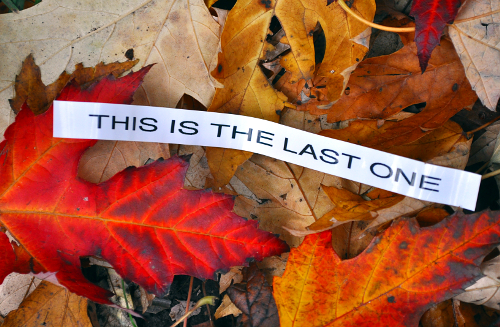This is the Last One (23 Happenings in 23 Locations of Identical and Arbitrary Significance)by Porsche Jones 
This is the Last One is art in six phases: -conceptual -geographical -performance -installation/material -social -video 1. Conceptual Simply put, the task is this: to apply 23 small, identical stickers in 23 locations of personal and private significance to the artist. The significance of the locations need not be disclosed. The stickers are applied in a specific sequence: that is, a chronological order. The order of the Placements reflects the order in which their locations became significant in the life of the artist. Thus the performative Placements of the stickers (art) recreate a chronology of actual events in the life of a human being. Each sticker reads, "this is the last one." They are all identical. This phrase implies a timeline which, in actuality, is entirely subjective. The order in which the stickers are Placed may not be the order in which they are Experienced by a viewer. In fact, without appropriate briefing, a viewer who reads one sticker does not have any knowledge that there are others in existence. The phrase "This is the Last One" isolates the participants in the project into their own subjective chronologies. The phrase is simultaneously true and false. When applied to life experiences, "this is the last one" has a certain morbidity; it evokes the uncertainty of the placement of our death in our timeline. 2. Geographical It begins with a list of 23 sites. The 23 locations are all in Buffalo and the surrounding area, and will be plotted out on a physical map before undertaking. The creation of this map makes these arbitrary landmarks destinations in their own right. The imperative to search for and "discover" the 23 landmarks, and also to alter them with the establishment of art, allows the project to become a quest. Each space is altered by its discovery and use until a new landscape emerges. It is a landscape that is made by searching. 3. Performance The way in which the Placements occur is vital to the project. The placement of stickers is an act of altering, an act of creating new meaning, but also, the stickers are representative of events in a human life. Thus the Placement is a kind of ritual invocation, an act of summoning. It is an act of sympathetic magic: the creation of a new, subjective, social timeline by the recreation of an historic, personal one. This act of "magic", taken together with the "quest" motif mentioned earlier, begins to generate a system of characters suitable to the performance of this act. Discussion of these characters will resume under "video." 4. Installation/Material Obviously, the design of the stickers is a factor. They need to be identical and legible. They need to be discreet and easily detachable, for purposes of avoiding prosecution due to vandalism. The stickers themselves are ephemeral and designed to be discarded. They are therefore non-vandalism. They are mainly just a prop of the performance and video aspect of the project. That is why they are designed in black and white, simple text, with no embellishments or flourish. Any additions would distract from their message and purpose. 5. Social Some of the locations will be blatant and some will be very discreet. The interaction of the general public with the stickers is inevitable. The following events are expected: -some of the stickers will be removed and discarded without any consideration -some of the stickers will provoke questions, discussions, or consideration -some of the stickers will be removed after consideration -some of the stickers will go completely unnoticed, and wear off on their own accord This is an important phase of the project. It questions the way in which the general public responds to images and events in each others lives. Of course, there is no way to accurately measure this response. However, what does it mean if even one sticker remains unnoticed and untouched? How do change blindness and paradigm paralysis isolate us from each others' experiences? 6. Video The video of the actual placement of the stickers is visible here. A list of the 23 locations used is viewable here. Some Minor Influences: Daniel Buren's "Legend I" (1970); Jenny Holzer's "Truisms"; Nick Cave's "The Birthday Party" |
